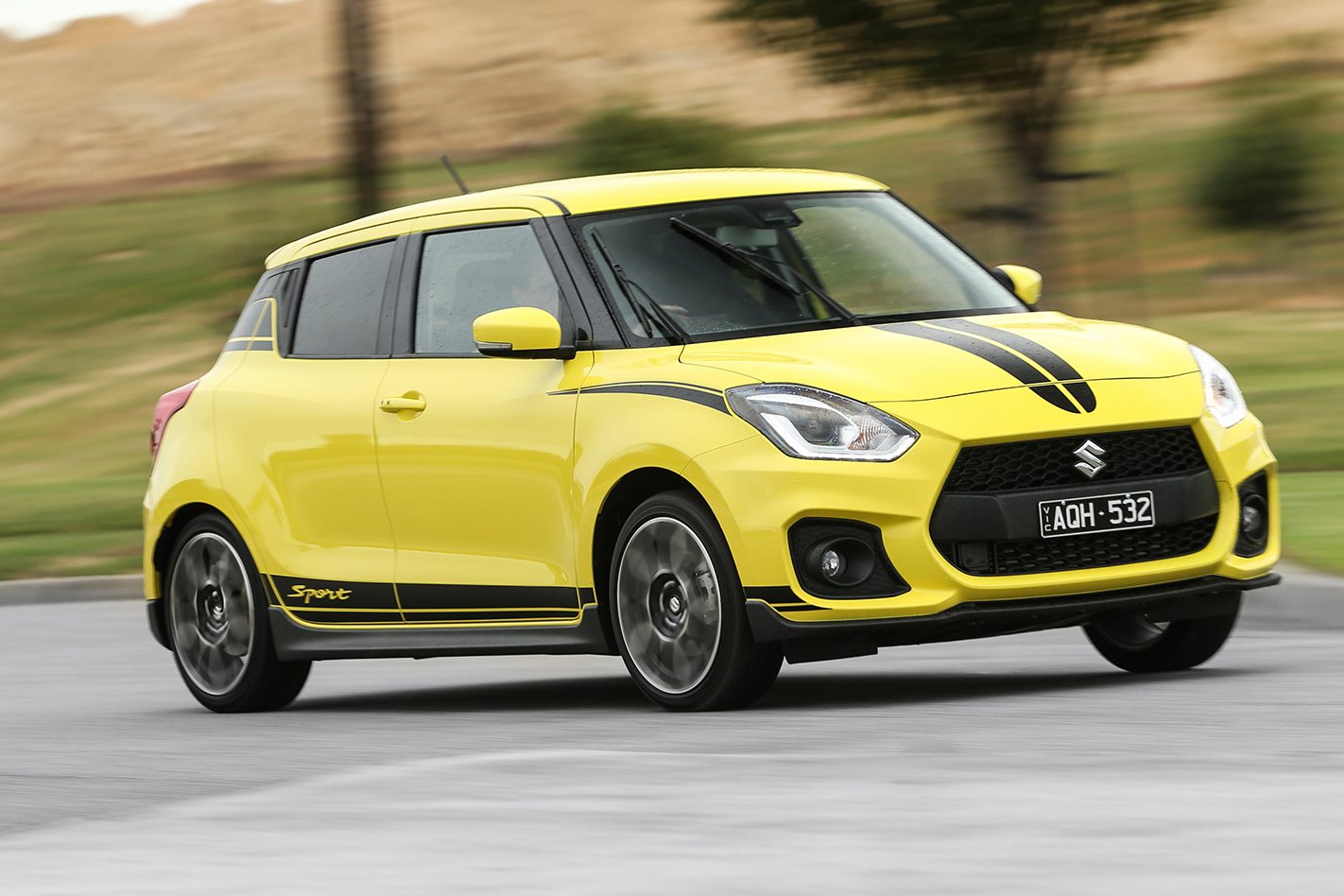
IT HAD been a swell two months behind the wheel of the Swift GLX Turbo, but to be brutally honest I was pretty keen on handing it back by the time week eight came and went. The GLX is a terrific thing, but returning it to Suzuki meant I’d be able to hop straight into an even more appealing Suzi – the feisty Swift Sport.
And so as I motored down the street toward Suzuki Australia’s headquarters, in Melbourne’s industrial south-west, I found myself involuntarily grinning. The third-gen Swift Sport was a giggle-inducing joy at its local launch at Victoria’s Broadford race track, and I’ve been itching to spend more time in it since. However, as I steered into Suzuki’s driveway my smile began to fade.
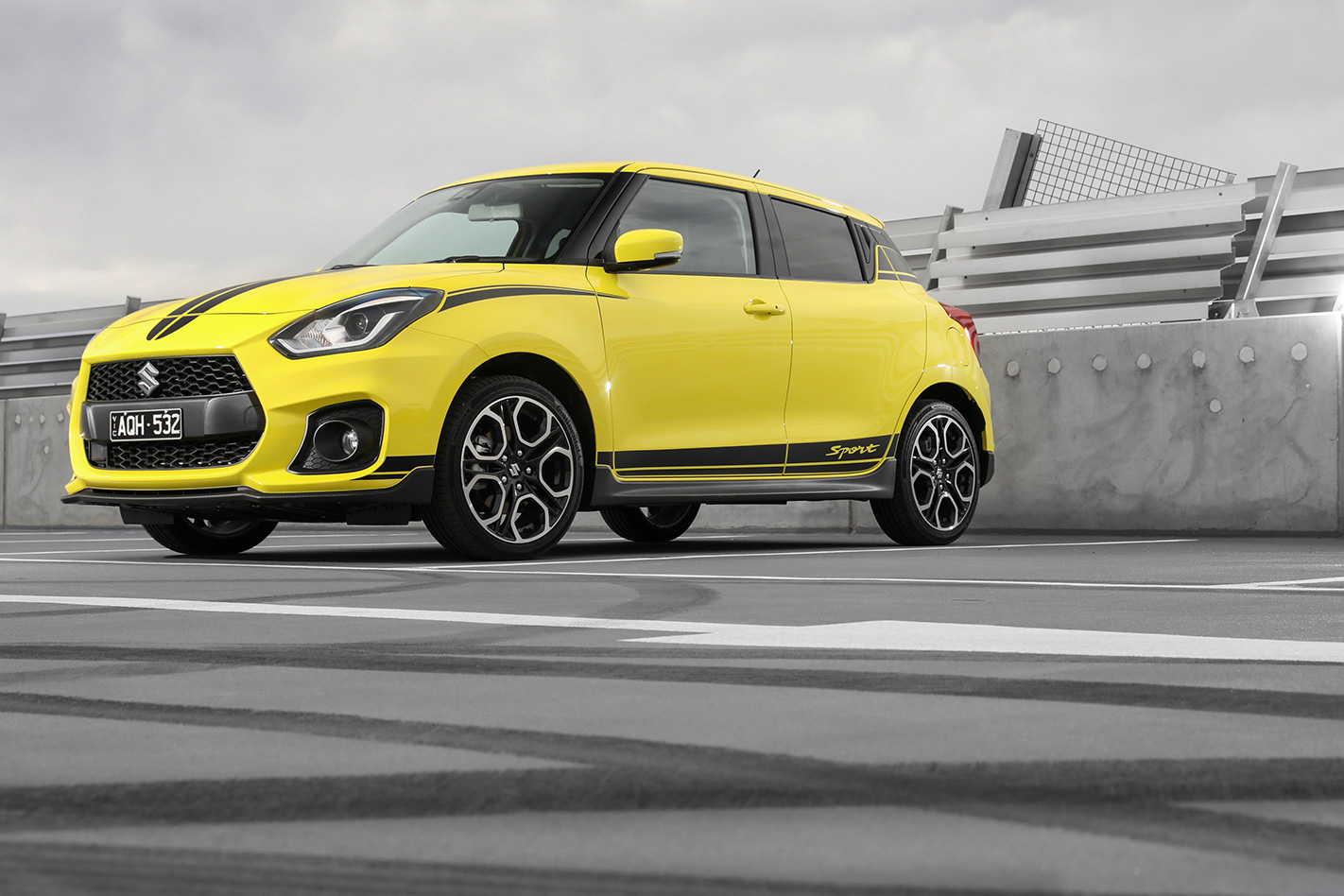
There was my Swift: parked, polished and ready for the handover. The only problem was it was festooned with stickers.
Don’t get me wrong. I’m all for the tasteful application of decals on cars, and anyone who knows me will confirm that I have a peculiar fetish for ’80s-era door stickers that say things like INTERCOOLER 4-VALVE DOHC TURBO in large block letters. However the graphical, erm, enhancements on my Swift Sport are just a little too juvenile for my tastes.
The stripes on the lower doors and up on the C-pillar are actually okay – I appreciate that the former loudly proclaim this to be the SPORT, in case the Champion Yellow paint didn’t clue you in – but the winged eyeliner on the headlamps and the cloven hoof bonnet decals seem unnecessary. They’re also printed in a faux-carbon weave, another of my pet hates.
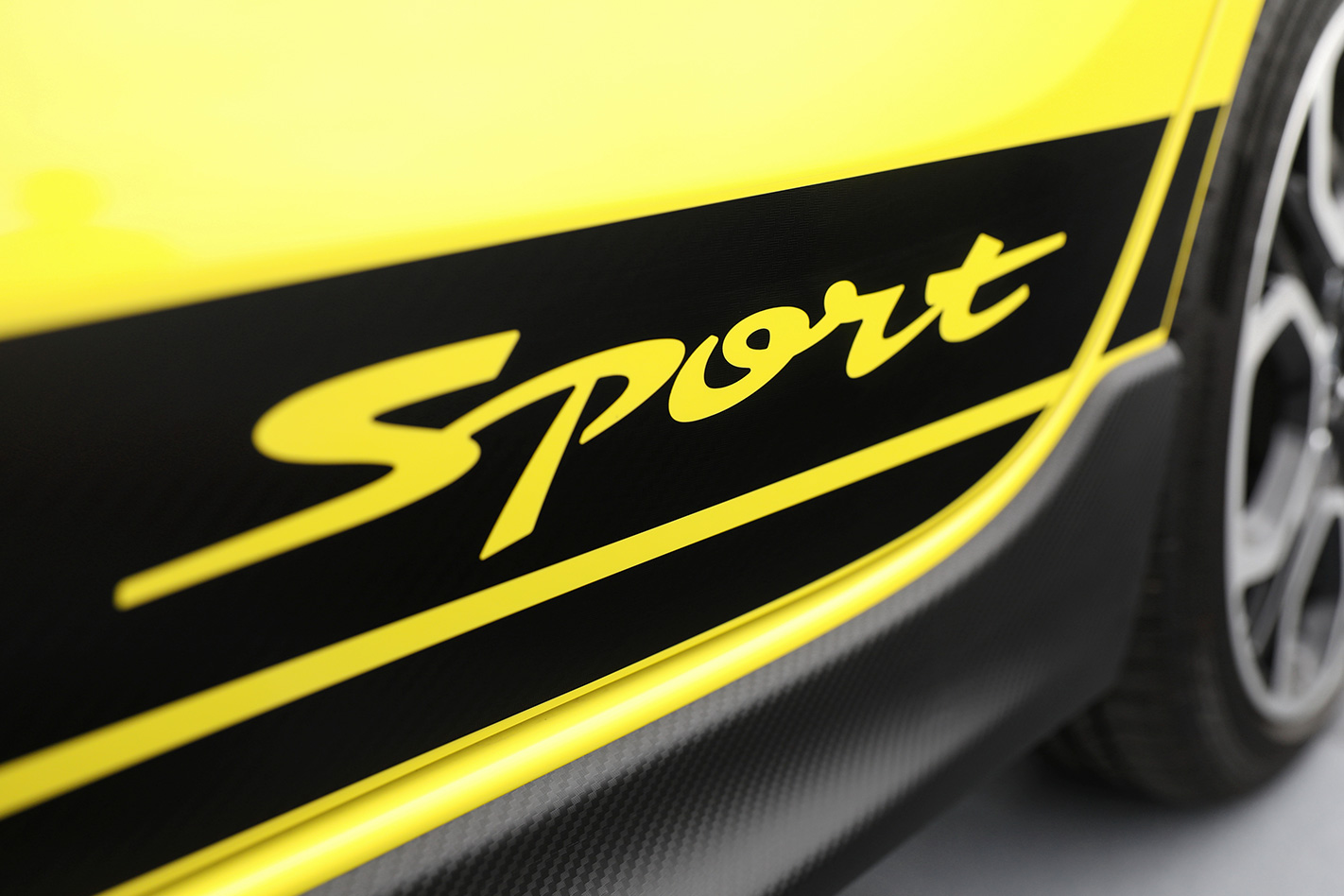
Or maybe I’m just being a snob. I’ll let you know if I still hate the stickers in four months.
I know, I know, I’m sounding tremendously ungrateful, but here’s the thing: the Swift Sport could be plastered in a My Little Pony livery and I’d probably still drive it. Even the cringiest exterior accessories can’t diminish the sheer fun-factor of the spiciest Swift.
And it’s not like you can see those decals from the inside, where your bum is hugged by superb bucket seats and the red-faced tacho hints that this ain’t your gran’s Suzuki. I’m still unsure whether I approve of the dot-matrix red trim on the dashboard and door cards, and some might argue that the cabin furniture doesn’t bear enough differentiation from the GLX Turbo that sits beneath it. I’m not of that view.
Sure, some extra soft-touch surfacing would be welcome (especially inside the centre console storage tray to stop phones from sliding about), but let’s not forget this car’s roots as a budget light hatch.
Anyway, all is forgiven once you hit the starter button and get stuck into that joyously boosty 1.4-litre turbo. It’s got astonishing flexibility in around-town driving thanks to an abundance of low-end torque, and the Sport’s featherweight 970kg kerb mass means the effect of those 230 Newtons of twist is far more profound than the bald figure would suggest.
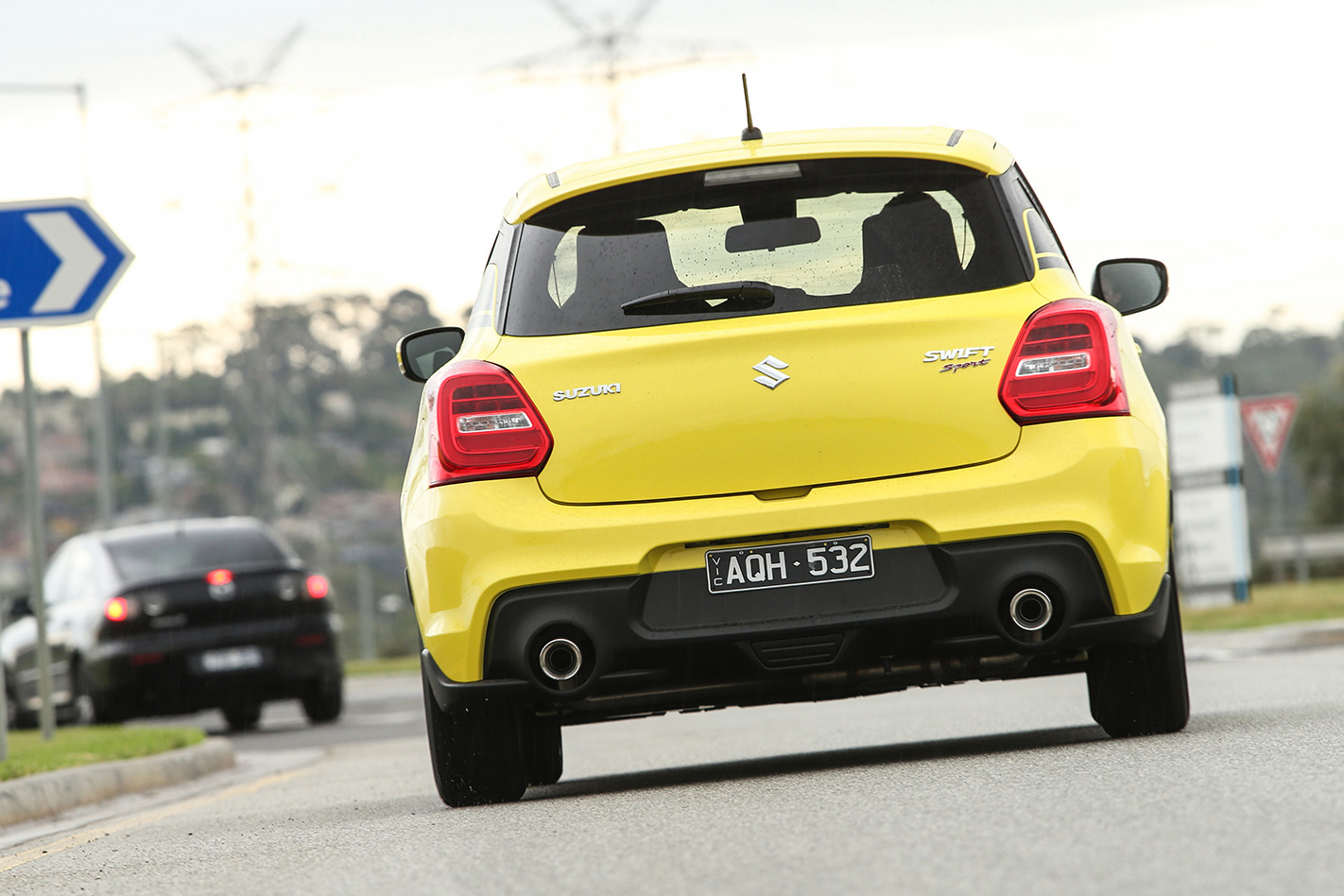
Peak torque arrives at between 2500 and 3500rpm and doesn’t sharply tail off thereafter, which means that commuting is a much less frenetic task than it was in the last-gen Swift Sport, whose atmo 1.6L needed loads of revs to extract meaningful oomph. Cruelly, commuting is pretty much all I’ve been able to do in it so far – I picked up my decal-clad Sport just a few days before heading off on a three-week holiday.
My loss will be a colleague’s gain, but once I’m back I intend to give the Sport a damn good strap – hopefully at speeds fast enough to peel off a few stickers.
Update #2
By Daniel Gardner
I USED to think the best way to evaluate the day-to-day ride quality of a hatchback was to find a poorly maintained bit of road and do some laps, but I was wrong.
What you actually do is get carried away at the gym and give yourself something called a ‘vertebral subluxation complex’ between C6 and C7. Ride quality takes on an entirely new meaning when you feel as though someone has left a kebab skewer in your neck and you’re walking around like a droid that can’t look up or left.

So you might imagine my life was hell standing in for O’Kane and looking after his Swift Sport for a few weeks. I’m already a big fan of the Swift GLX Turbo but this performance-enhanced version has stiffer track-tuned suspension – a feature that threatens to loosen the bladder of someone with a neck injury.
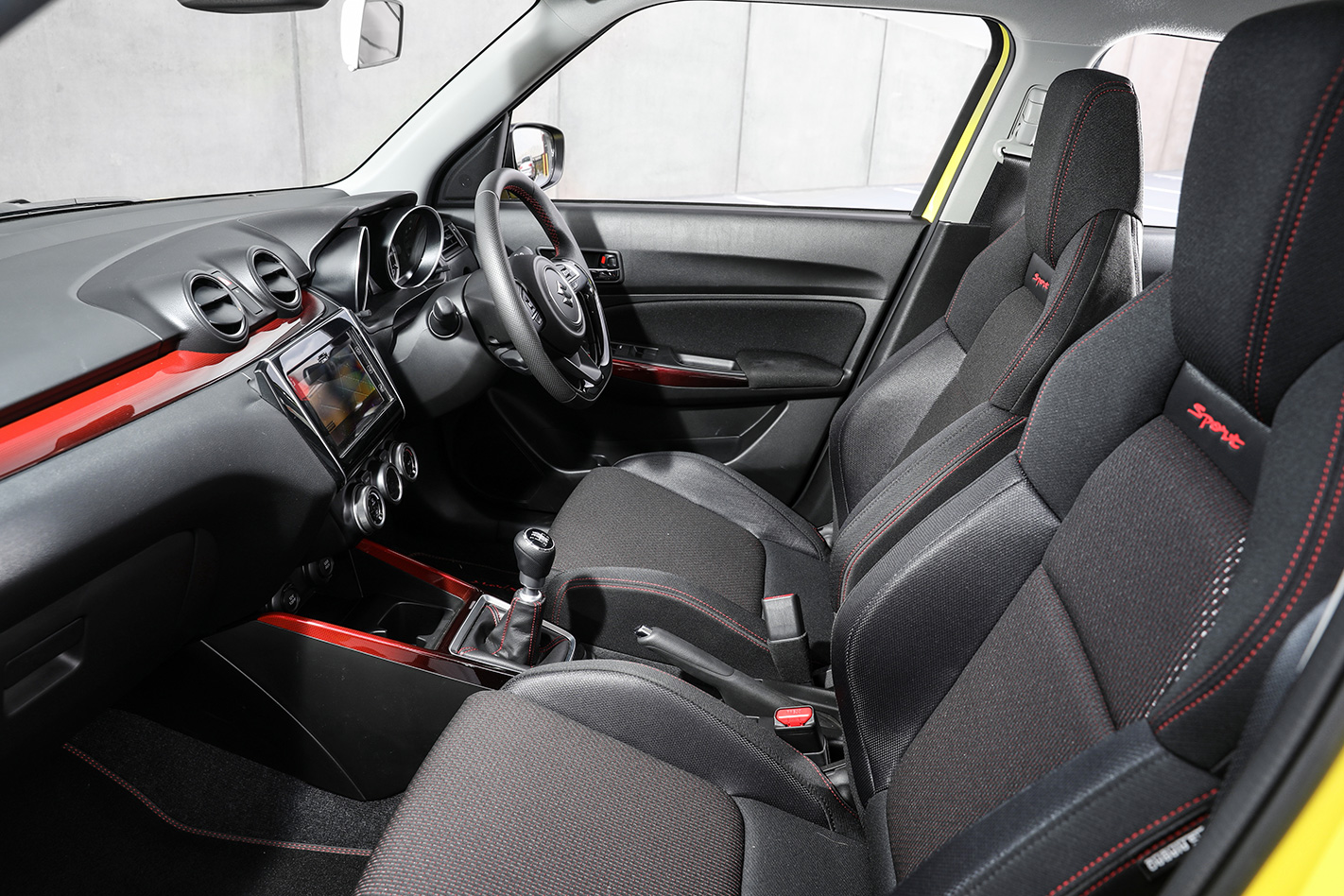
Far from being unrelentingly stiff, however, the Suzuki realises its performance gains through minimisation of weight and deft chassis tuning. The result is a car that was fast and enormous fun before I injured myself, but still comfortable and forgiving for trips to the chiropractor after.
No doubt its 103kW/230Nm would get to the ground more effectively if an LSD was standard, but then it wouldn’t be a $25,490 proposition and there’s something satisfyingly involving about the way its front end wriggles around, even in the dry.
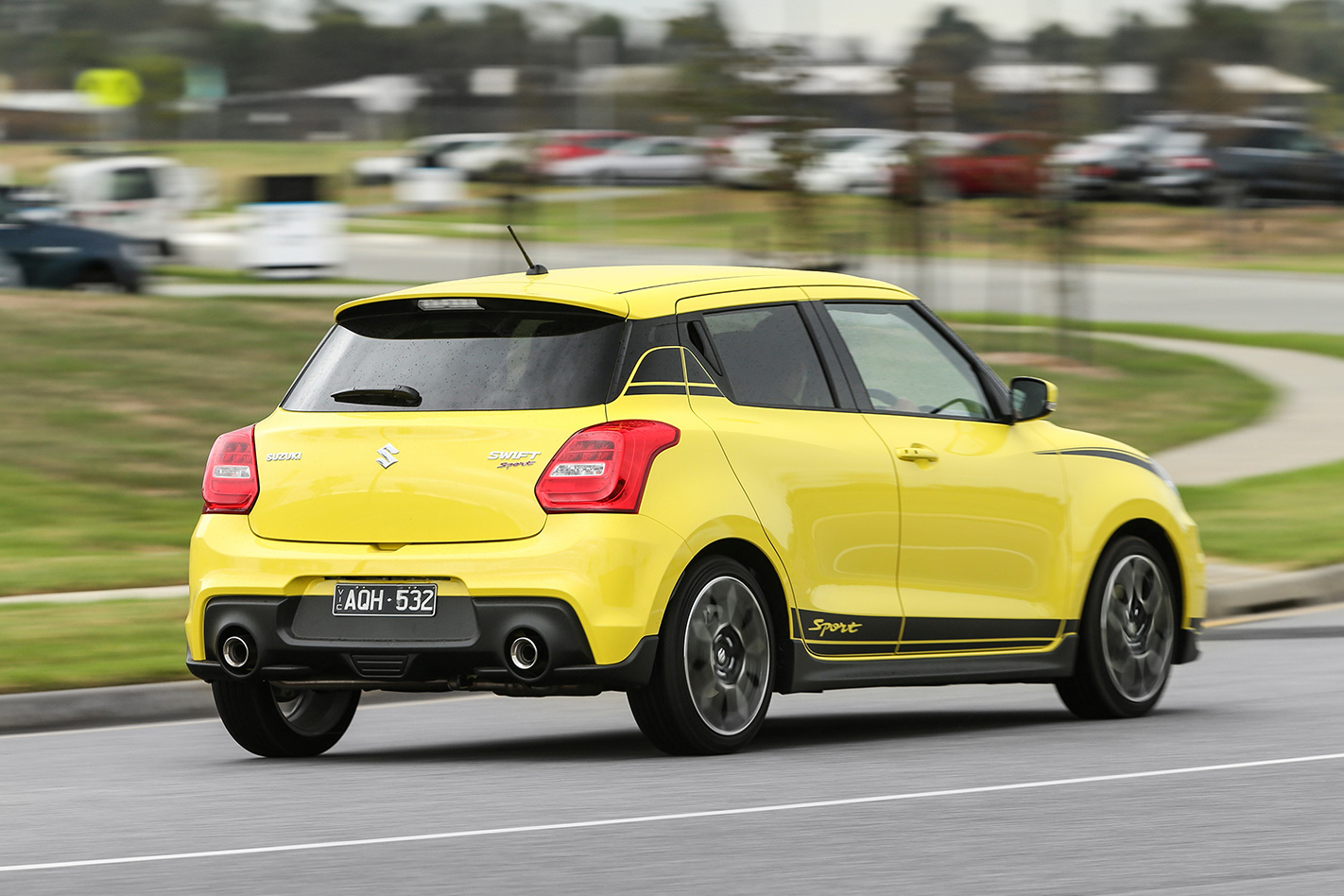
Either way, the Swift lives up to its name and certainly is quick. DIY shifting is standard (a six-speed auto adds $2000), and while a more decisive shift action and more aggressive clutch would enhance the experience, the manual Sport is a must. Its six ratios are bunched tight and combined with a short final-drive for peppy acceleration, but the downside is an engine that revs at 2750rpm at 100km/h in top.
I particularly like the absence of a ‘sport’ button too, which is often used by other brands to sharpen key controls. The Sport is permanently in sport mode because it says so on the boot. However, a little more exhaust note would add to the cause.
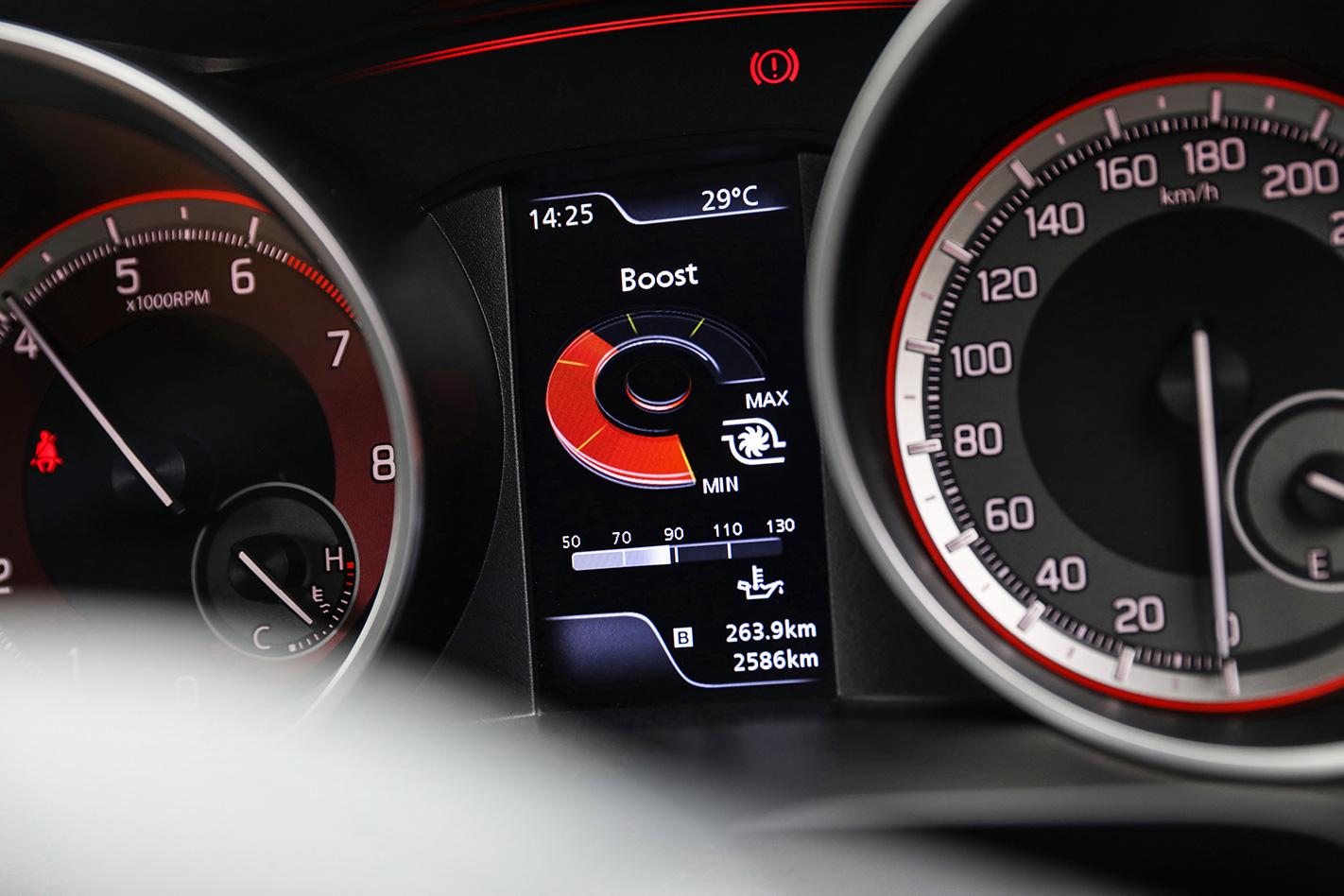
My only other qualm are the hyperactive driver assistance features, with collision warning and lane-departure warnings frequently interrupting the digital turbo boost gauge (one of my favourite features). The safety tech is commendable in a car this price but it shouldn’t detract from the driving experience.
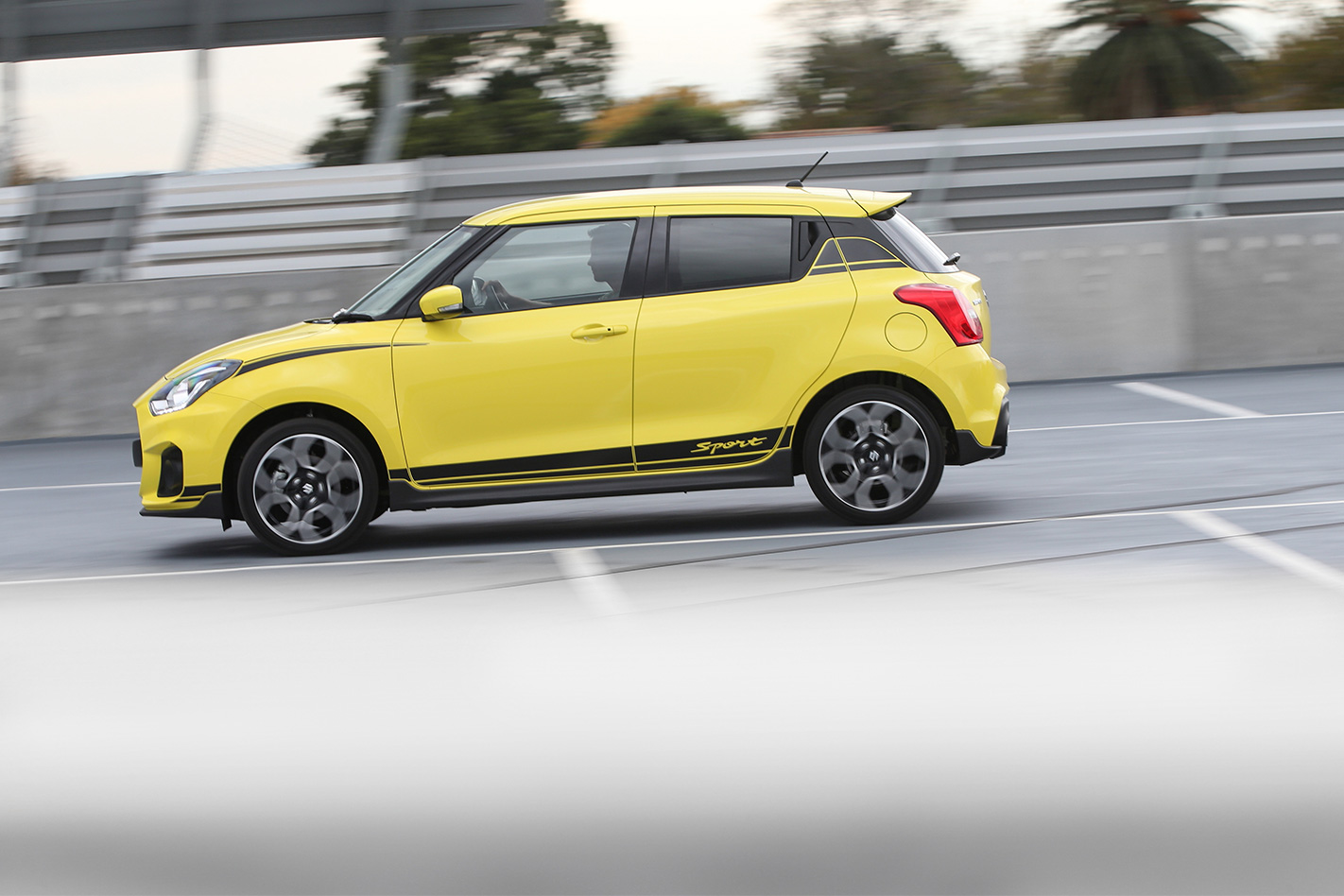
So there you have it. The Swift Sport is quick, chuckable and has a ride that won’t snap your neck. Which is lucky because it seems I’m quite capable of doing that by myself.
Update #3
Want to know what the most impressive aspect about the Swift Sport is? It’s not its ability to devour corners, nor its pleasingly direct steering, nor its boosty 1.4 litre four. It’s the way it sheds speed when you stand on the middle pedal.
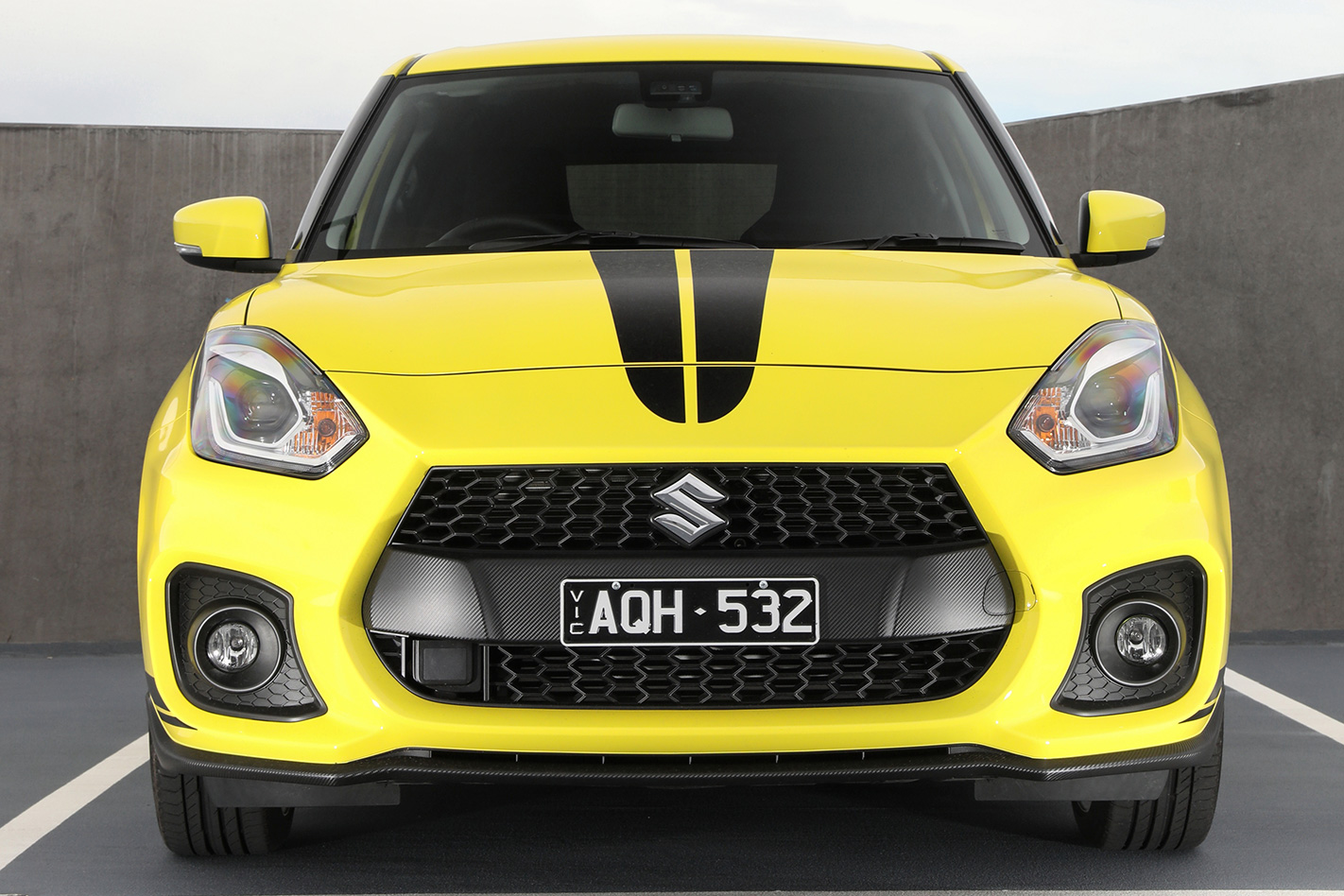
I really wasn’t prepared for that. The latest Swift Sport might be the fastest in Suzuki history, but it’s still far from what you’d describe as ‘rapid’. Hustling it quickly on a mountain road is an exercise in preserving momentum, and you aim to avoid hitting the brakes as much as possible for fear of washing off all that hard-earned forward motion. I hadn’t really had a pressing need to push the Swift’s brakes – until I took it to its first proper circuit outing.
Rocking up to Winton Raceway for a club track day, the Sport felt just a smidge out of place. Bone-stock and factory-fresh, rolling through in the bright-yellow Suzuki gave me flashbacks to being a meek year 7 student entering a high school locker room for the first time, only to find it full of intimidating year 12s.
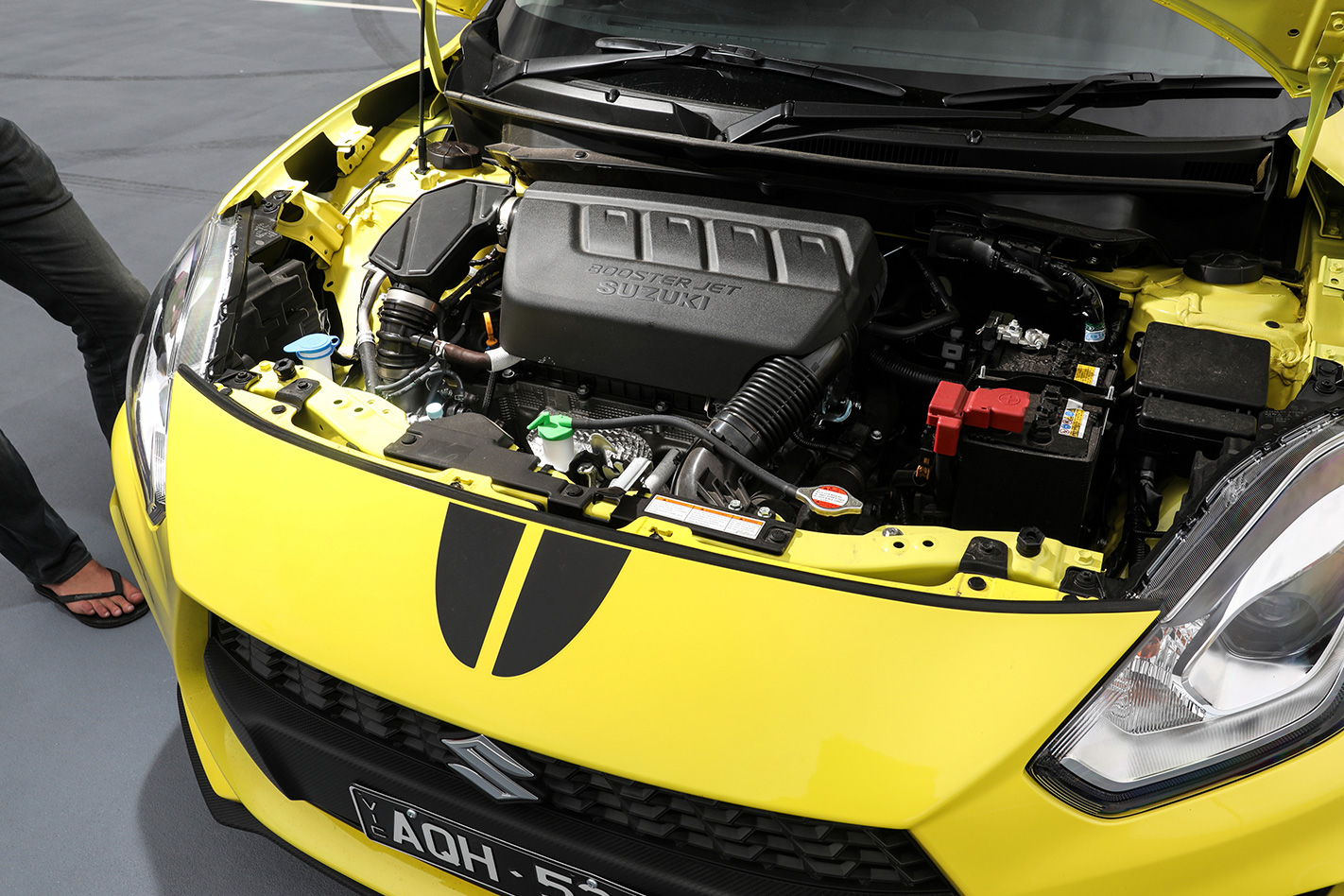
But on the circuit, the Sport proved to be a genuine athlete. The engine is probably the only part that doesn’t seem quite so suited to track work, given its low redline and top-end breathlessness. The best is wrung from it by short-shifting, leveraging its feisty slug of mid-range torque, but that hardly feels – or sounds – all that fun. It’s not difficult to tell the Sport’s engine was borrowed from an SUV.
Shifting the powerband further up the rev range would also perhaps tame the Sport’s front-end traction issue. With a surfeit of available Newton metres and an open differential between the front axles, it’ll easily spin up the inside wheel when loaded up in a corner. Fitting tauter springs or swaybars would help reduce that by containing some of the Swift’s extraneous body roll, but would come at the expense of ride comfort. A proper limited-slip differential would be the ideal solution.
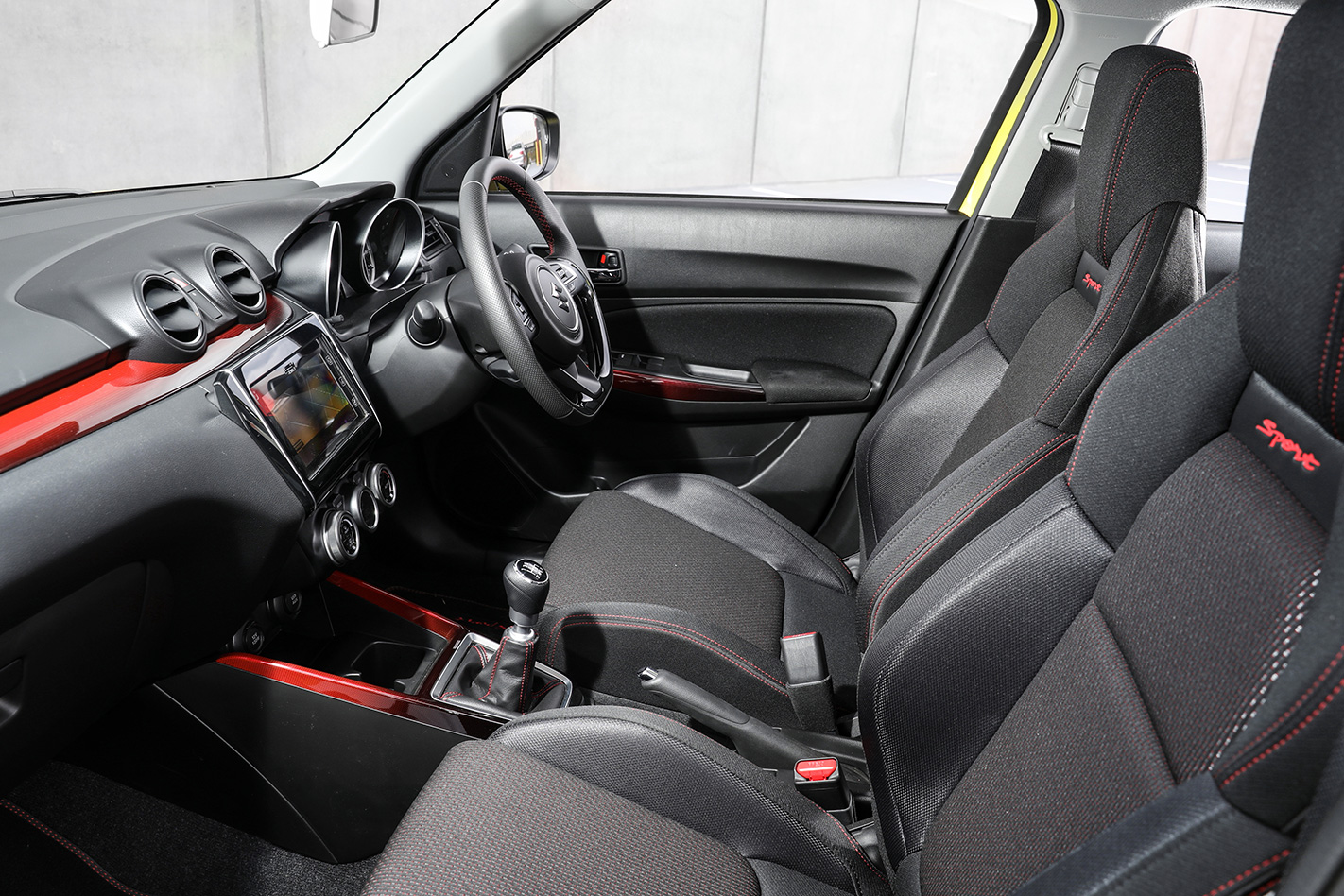
Everything else, though, is peachy. The direct, fast-acting steering is a delight, the Continentals surprisingly grippy and the chassis remarkably resistant to understeer and eager to rotate for a front-driver. The body-hugging bucket seats are also perfect for this kind of hard driving, while remaining comfy enough for the two-hour drive to and from the circuit.

And that brings me back to the brakes. Those pint-sized rotors and calipers are nothing special, but with less than a tonne to halt they’re eye-wideningly effective. So much so that my first stab of the brakes at the end of Winton’s front straight came 50 metres too early – braking points that made sense for virtually every other car I’ve driven there were meaningless to the tiny Swift.
And, like the rest of the car, the brakes were unbelievably durable. An entire day of hard lapping didn’t see them fade to any great degree, while there was still plenty of meat on the pads when it came time to head home. No warped rotors, no overheating engine, no warning lights, no problem.
Update #4
MY FIRST experience of forced induction front-wheel drive didn’t come in the form of a Golf GTI, Saab 900 Turbo or even a Renaultsport Megane. No, that initial taste of a boosted bum-dragger was supplied by a fairly unlikely candidate: my friend’s SV11 Camry, which was supercharged in the most ghetto way imaginable.
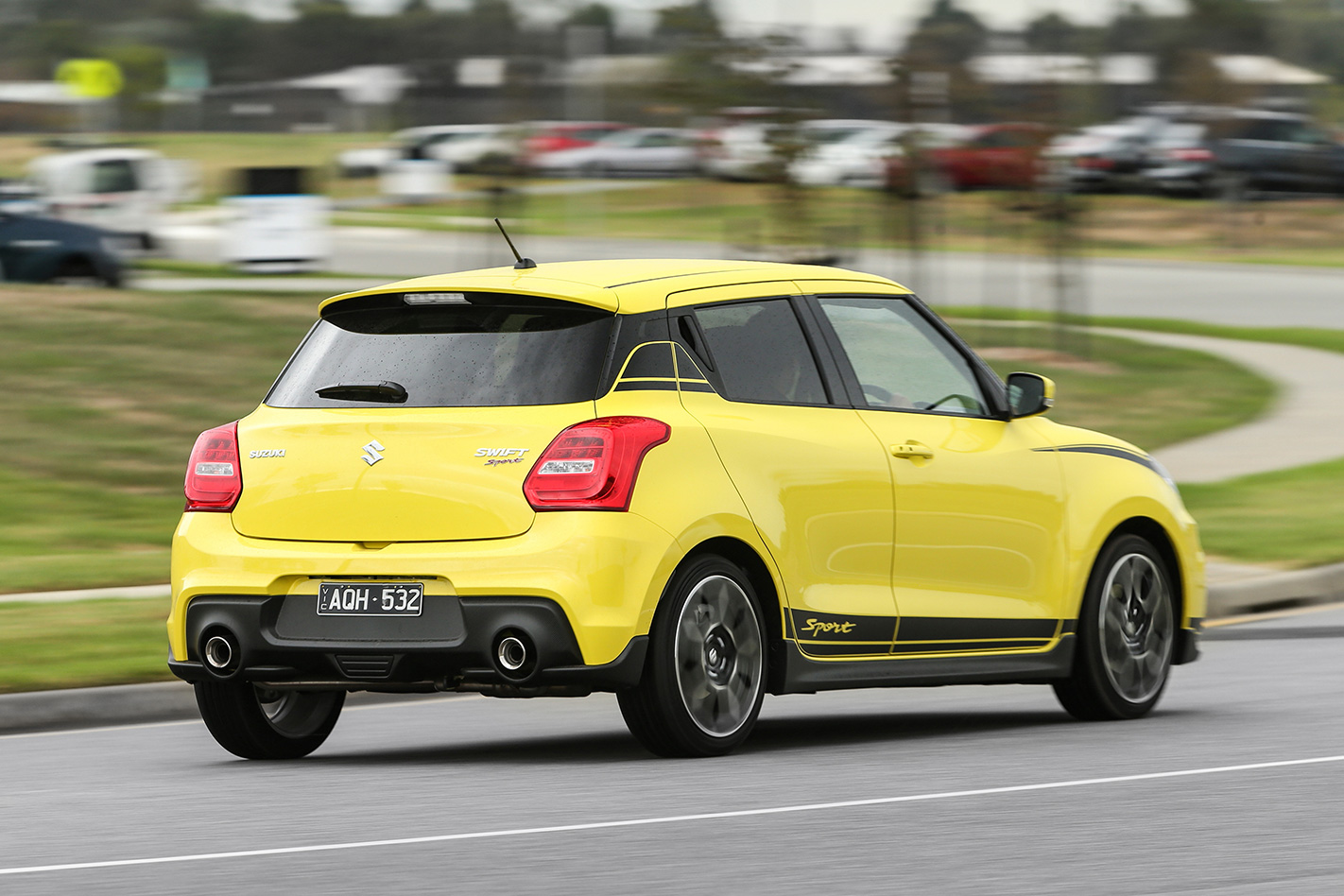
A crude bracket fixed an Eaton M90 to the side of the head, the belt tensioned by a length of twisted rope. For some added spice the supercharger’s electric clutch was hooked up to the windscreen wiper relay, so if it was raining you not only had to deal with diabolically sketchy traction, but you had to do so with a screen full of water as well.
Its greatest party trick was also one of its last. A particularly spirited burnout managed to generate so much heat inside the differential that it welded the spider gears solid, locking both axles together. No longer a single-pegger, the Camry could now lay down a ferocious figure-eleven indefinitely or, as it turned out, until a tyre exploded.
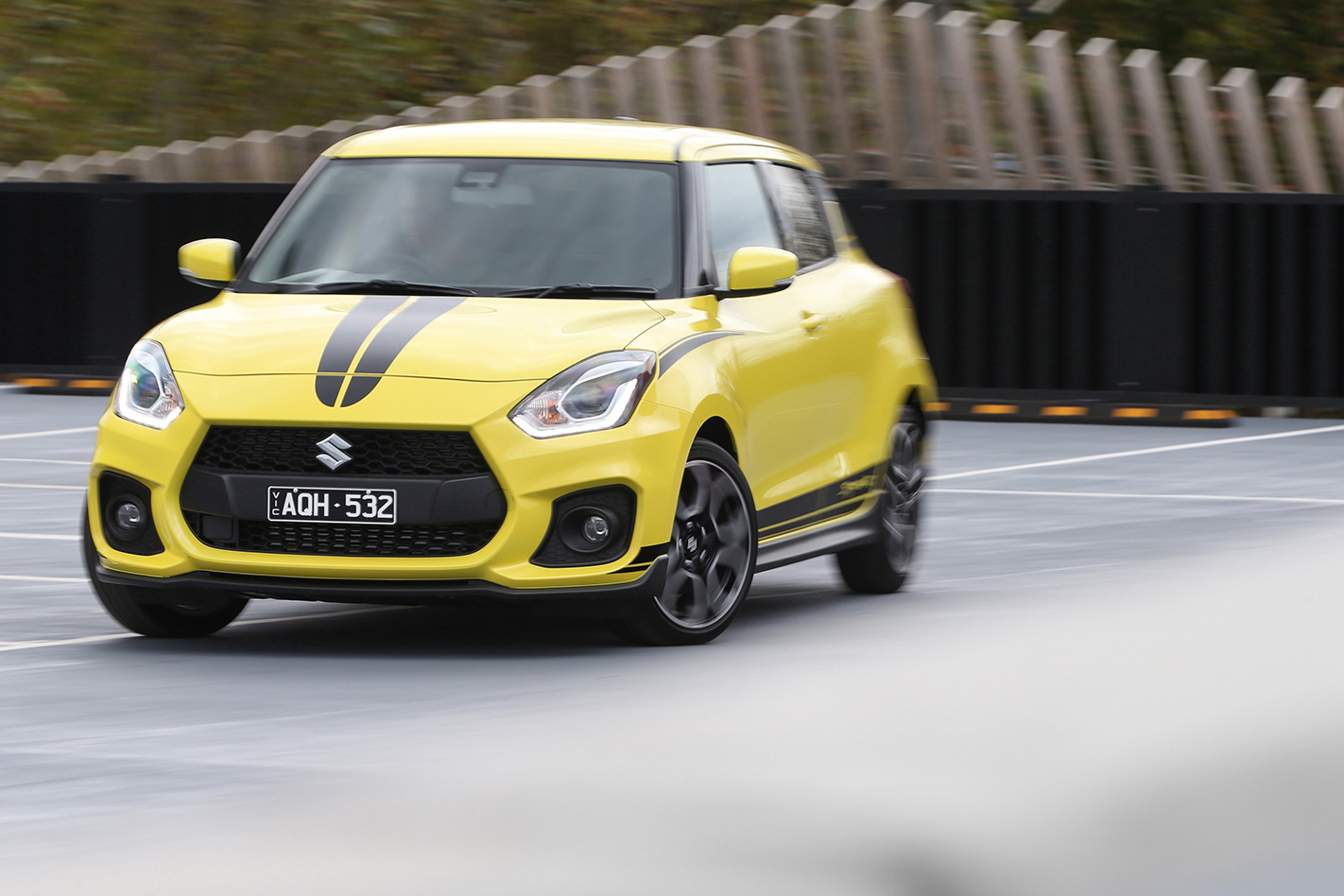
Why am I telling you this? Because that poor, tortured Camry taught me two things: that forced induction was the Horny Goat Weed that turned mild-mannered metal into ’roided-up tyre shredders, and that high-powered front-drivers are always better when both wheels can lay the power down.
The Swift Sport is far more civilised than that Camry – I don’t have to choose between boost or windscreen wipers, for example – but even so there’s clearly a bit of animal in its power delivery. It’s not old-school laggy, which is no surprise given its engine is a very lightly warmed-over version of the Vitara Turbo unit, but even so it easily spins an inside wheel in a corner when the turbo spools up, and generates plenty of bushing-bashing axle tramp on a hard launch.
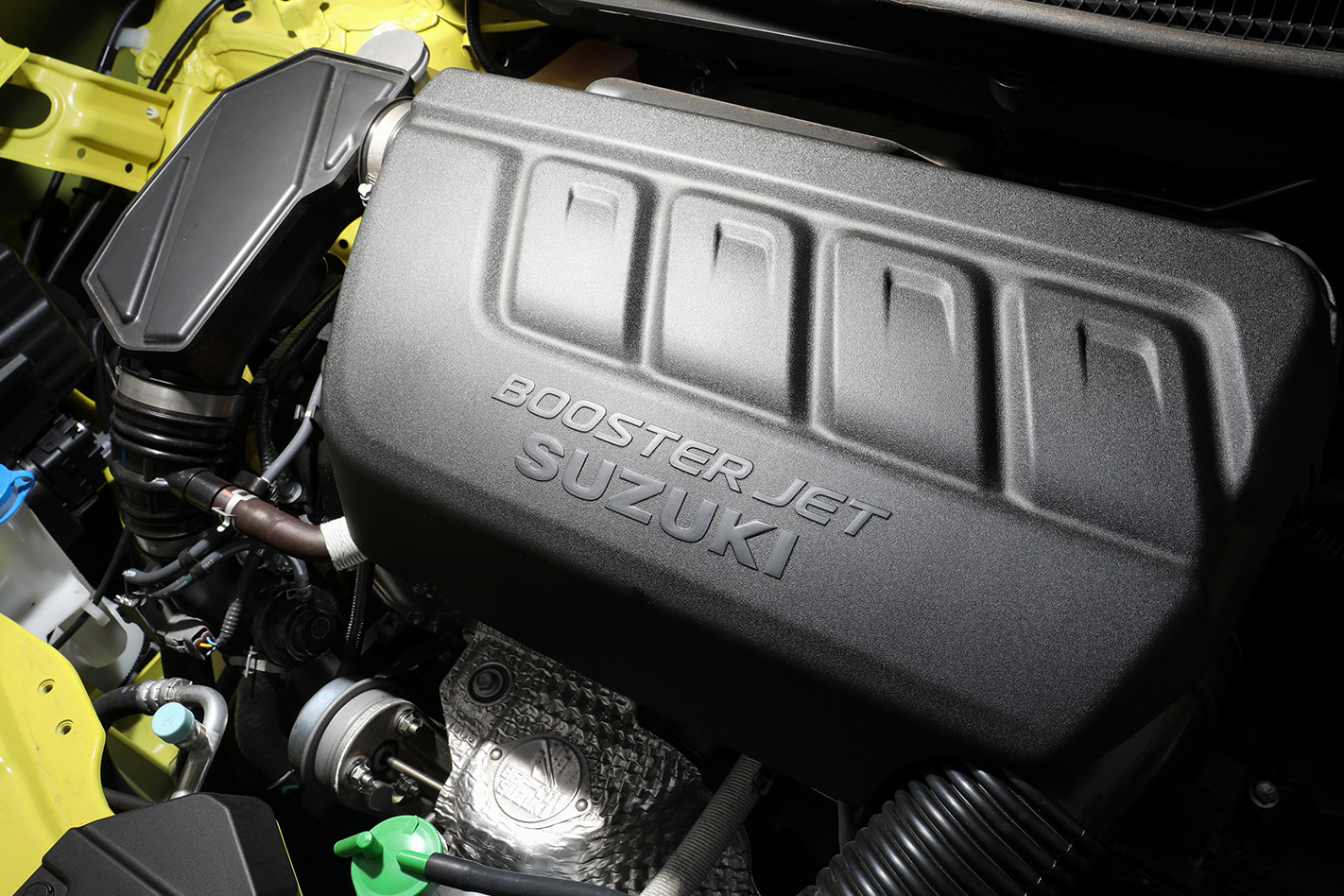
As I found out last month it’s nevertheless surprisingly quick around a race track, but even on the road the absence of a limited slip differential can be felt. The more time I spend at the wheel, the more strongly I feel that an LSD would allow the Swift Sport to put its best foot forward – quite literally.
Ford’s all-new Fiesta ST is coming early next year and for our market a mechanical LSD is standard. I’ve driven it in Europe both with the tricky diff and without, and the Fiesta is a proper weapon when it’s got the right hardware between its front wheels.
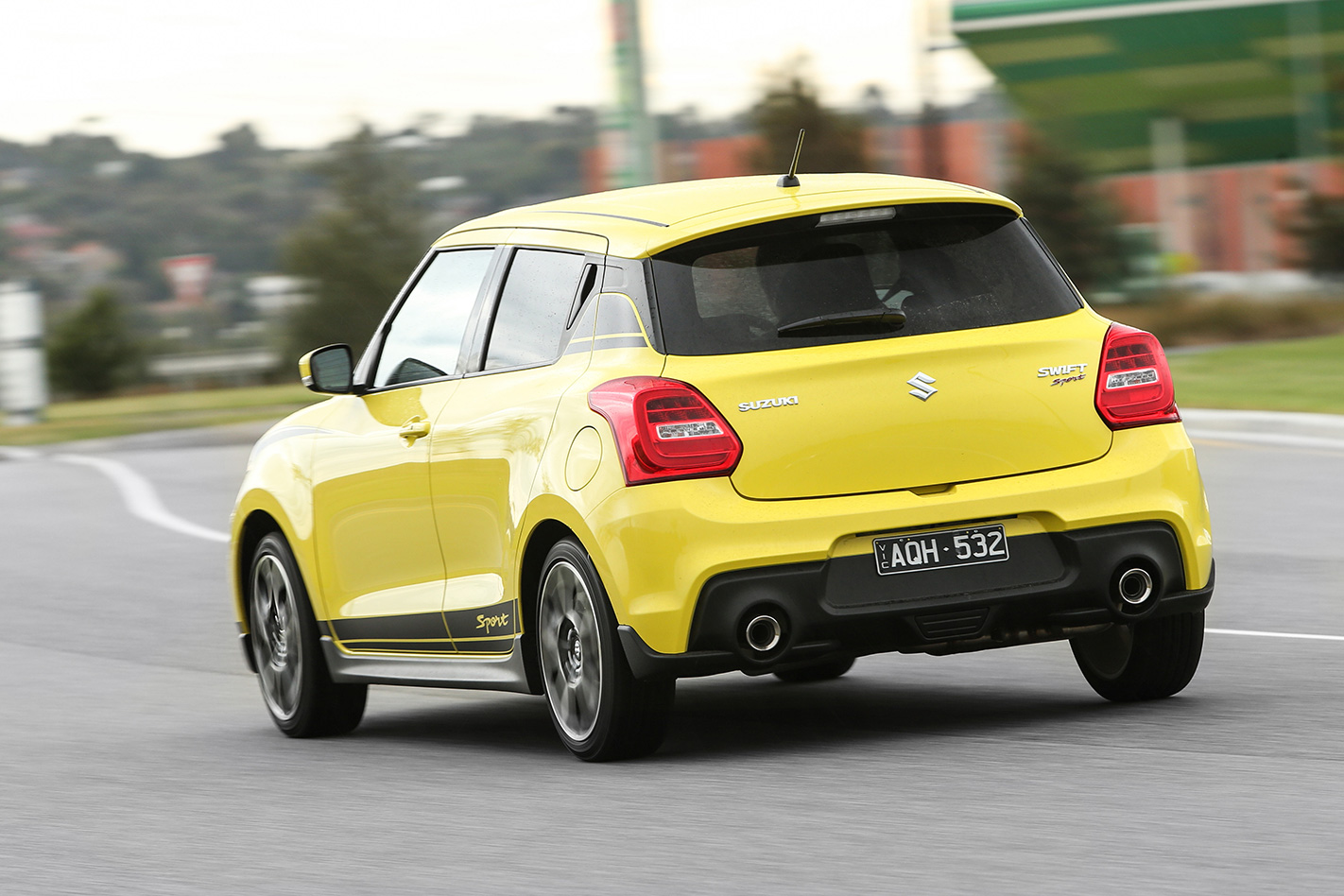
For the Swift to have any hope of keeping up with its Blue Oval rival next year, it’d need a similar treatment.
Farewell
FAMILIARITY breeds contempt, so they say, but like so many well-worn maxims that phrase doesn’t apply to everything. It certainly doesn’t apply to the Swift Sport I’ve been driving for the past five months.
I don’t want to give it back. That’s the summary of how I feel about it. Can you blame me? It’s light, chuckable, looks cool, is a cinch to park and sips fuel. The seats are great, it loves to be driven like a hooligan, and even the stress and duress of a trackday wasn’t enough to make it wilt. It’s a Jack Russell of a car, bursting with energy and playful to the extreme.
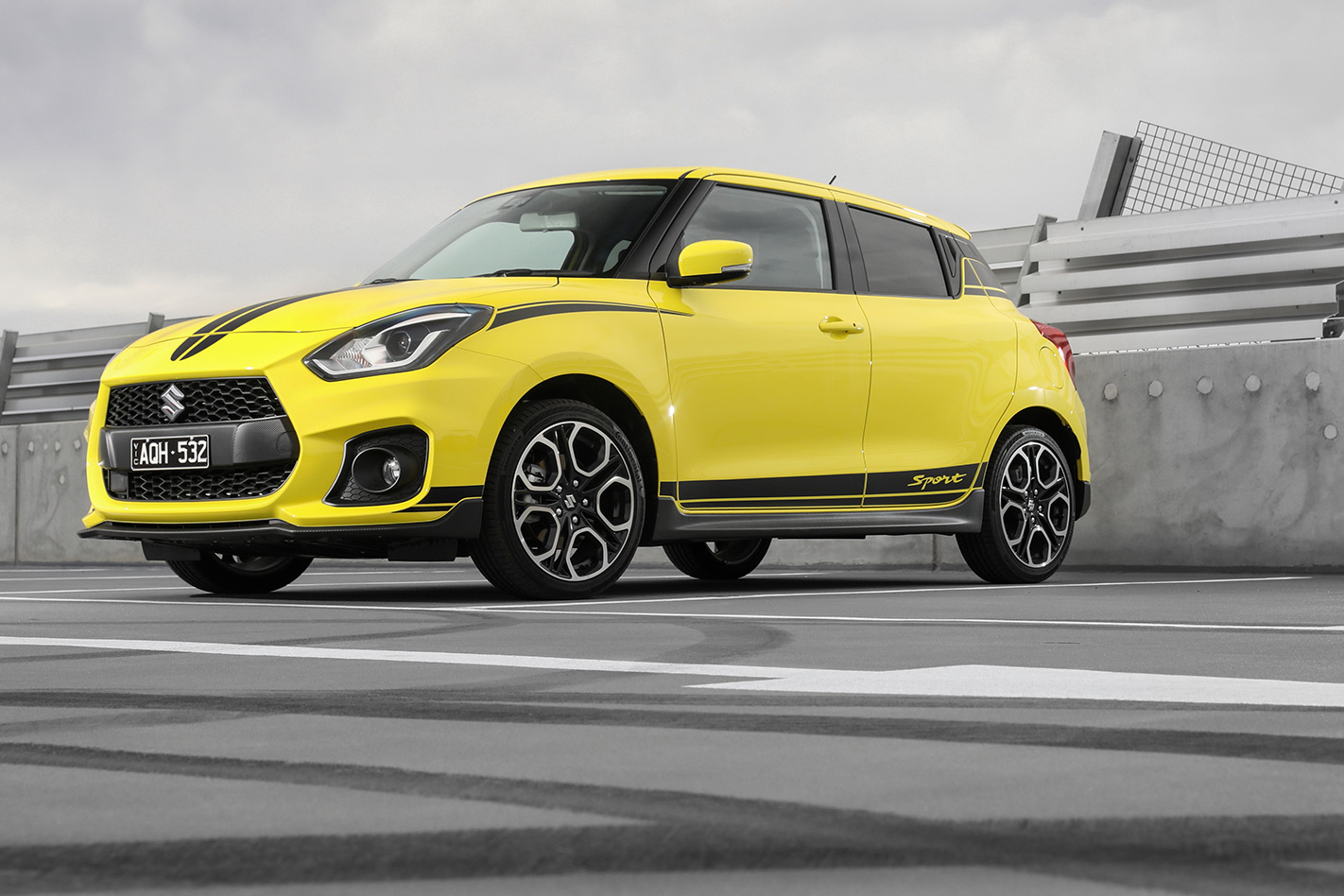
But this isn’t Stockholm Syndrome. I’m not going to ignore its flaws. For starters the gearshift action could be more precise (I just drove the new Corolla in base-model manual form and it has a tighter gate), and the exhaust note could be improved with some raucous bangs and burbles. The new Fiesta ST that’s coming our way next year sounds wicked, but sadly the Suzuki does not.
There are other niggles like some hard plastics where they should probably be soft, but it seems mean to mark down a mainstream B-segment hatchback for being built to a price. Even so, none of these issues were enough to dilute my enthusiasm for the Swift Sport. I’d hold onto it forever if I could, but sadly AQH532 is the property of Suzuki Australia and needs to be returned.
So I did the next best thing and persuaded my other half to buy one.
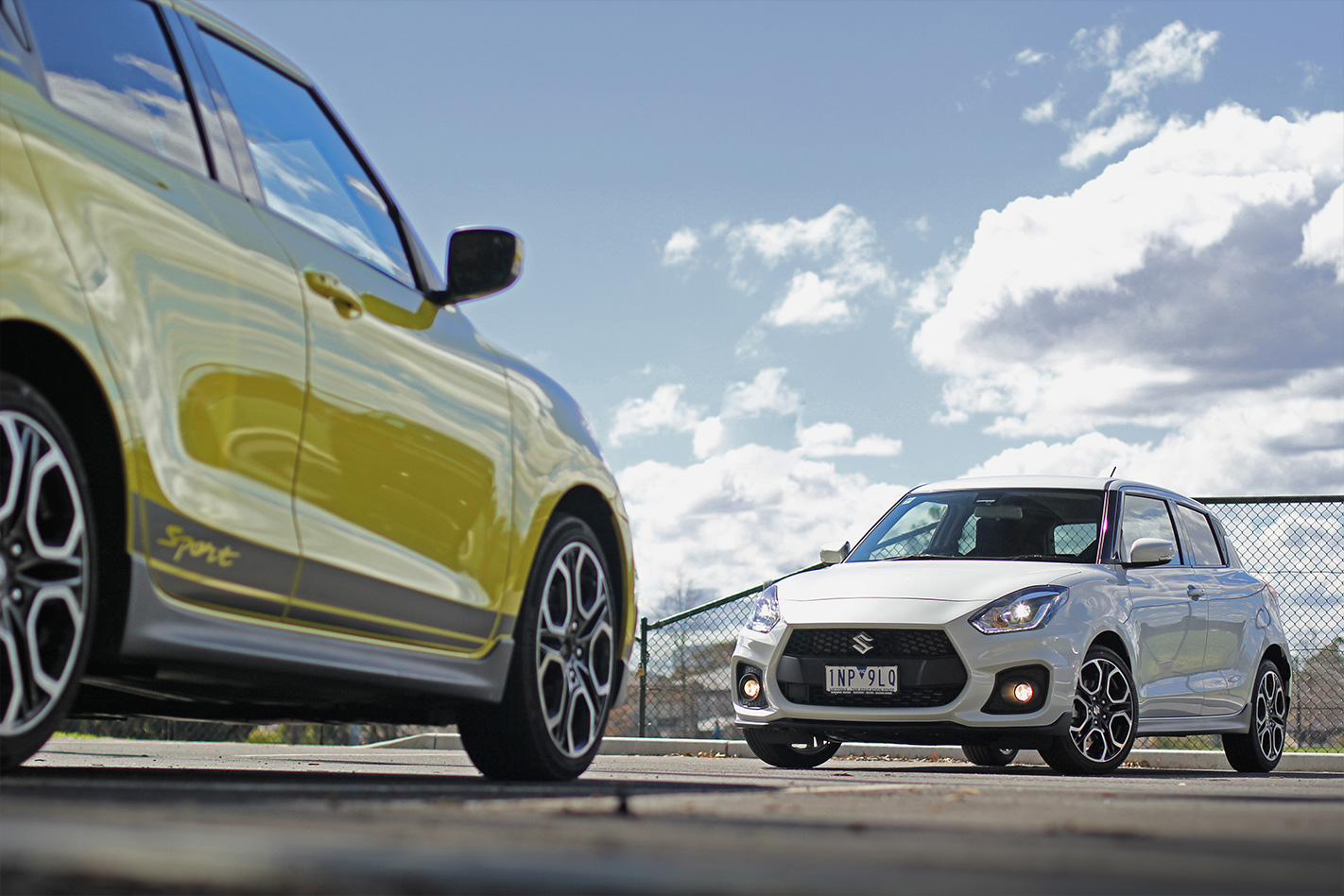
She didn’t take much convincing. Having the Swift Sport in my driveway for nearly half a year made it an easy sell – it’s a known quantity, after all, and given she’s spent many hours in the passenger seat she’s had plenty of time to decide whether she likes it or not. Other factors were at play too, namely the ability to run a novated lease through her work and the fact her existing car decided to fry its ECU.
To my eternal dismay my dear girlfriend is anything but a car enthusiast, but she nevertheless wanted something with a bit more attitude than the average hatchback, and that was also available with an automatic and priced somewhere in the mid-$20K region. Taking those criteria into account, it’s actually surprisingly slim pickings. The Clio RS200 Sport is an animal when put in Race mode, but costs north of $30K, the Mazda3 SP25 is too sober in its current generation, the Hyundai i30 SR is a smidge too expensive at $29K with an auto, the Fiesta ST is manual-only and Honda rudely refuses to act on my suggestion that it should produce a Jazz Type R.
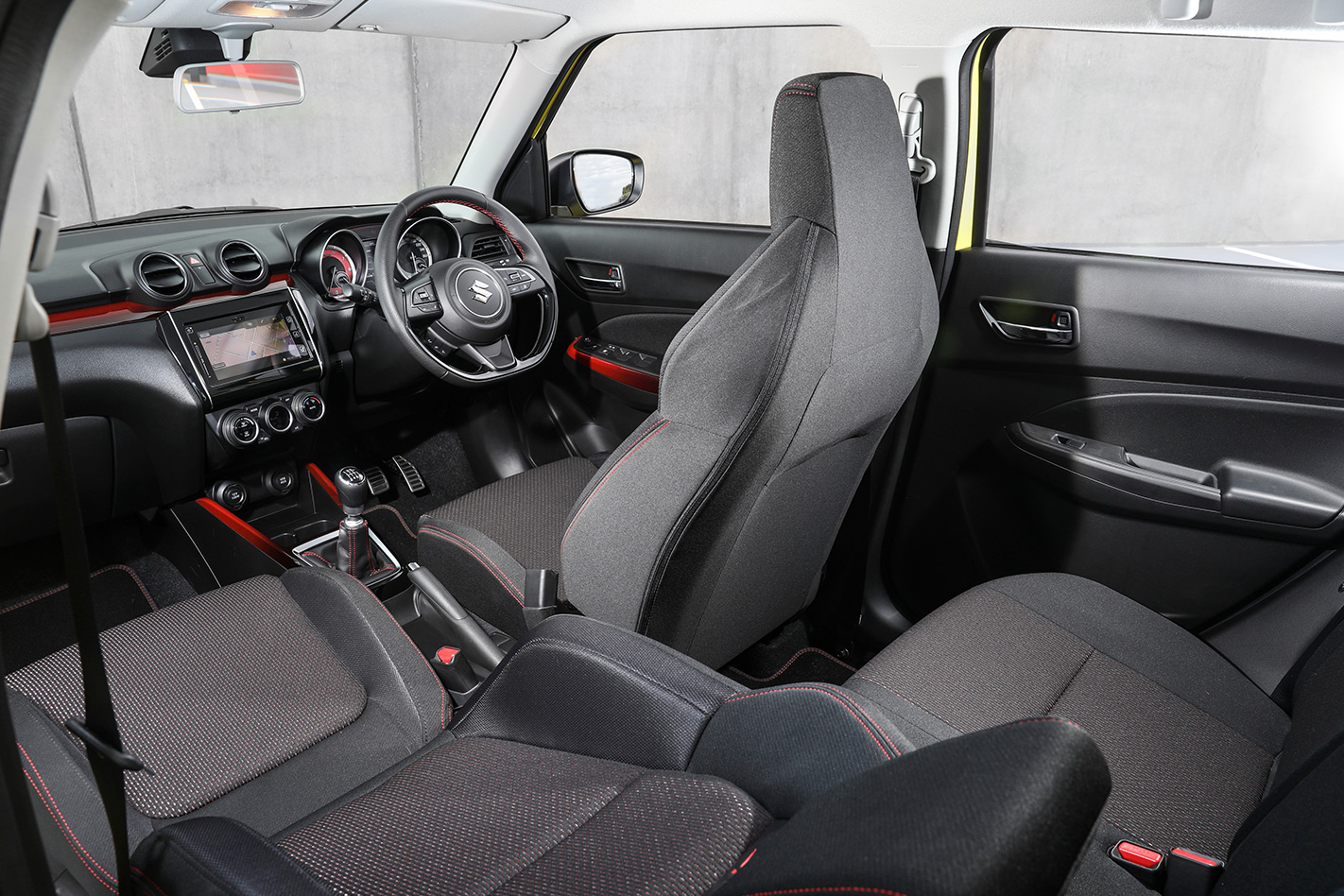
The planets were clearly in alignment then – the Swift Sport was the sweet spot. There was just one more hurdle – facing a car dealer.
If you believe the stereotype, car salesmen are greasy-haired, fork-tongued, slick-talking charlatans. Much like car journalists, in fact. The truth is somewhat different, at least as far as Suzuki’s sales staff were concerned. They ignored me almost entirely, but that’s because they homed in on the fact that it was my partner who was buying and not me. For an industry that doesn’t have the greatest reputation when it comes to serving women, it was encouraging to see. Kudos, Suzuki.
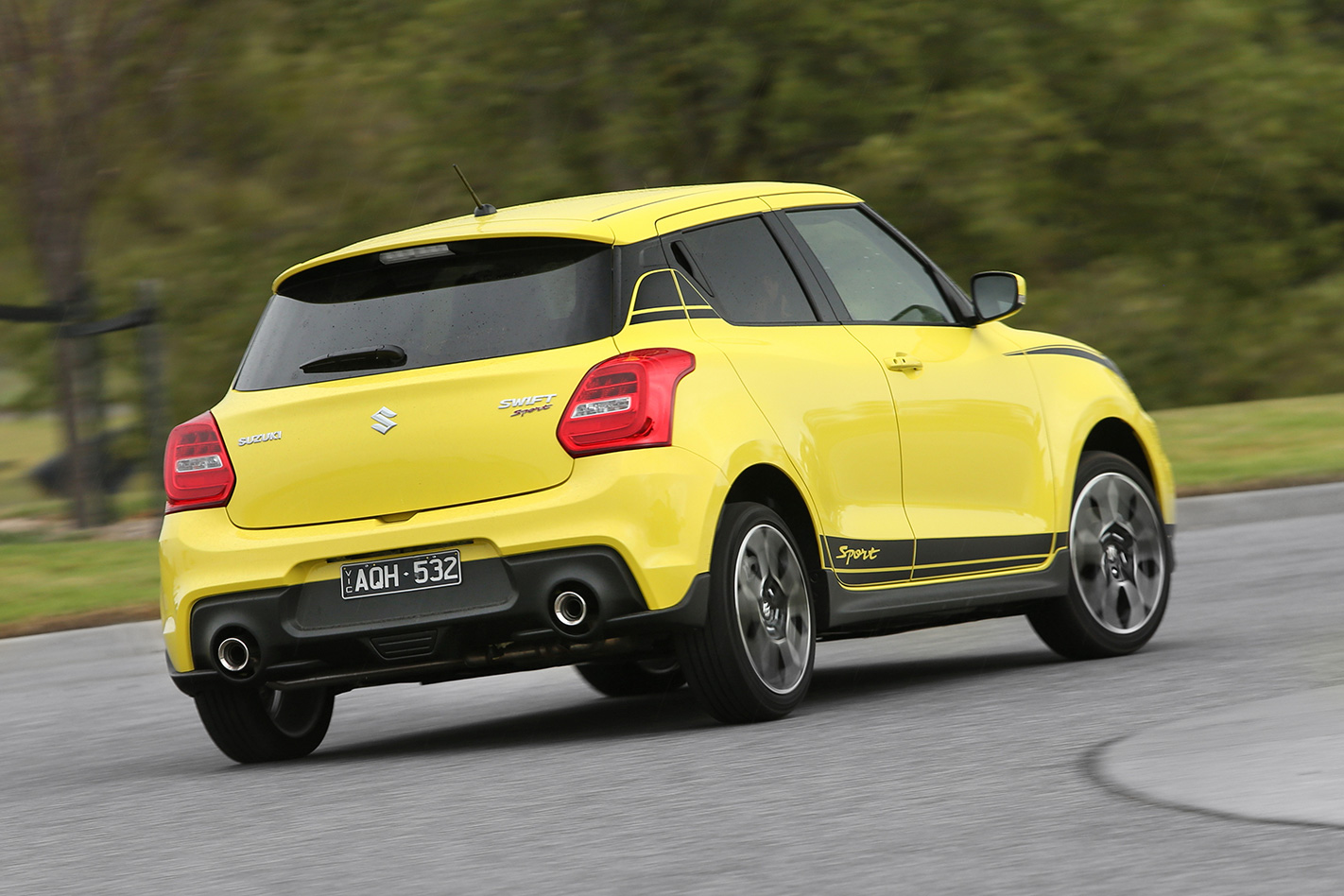
After a test drive and some fairly painless bargaining, we had an order in for a white automatic Swift Sport. The timing is perfect: as I wave goodbye to my Pikachu-yellow Swift, a vanilla-white example rolls in to take its place in the O’Kane garage. Except this time, this one’s going to stick around a lot longer.



